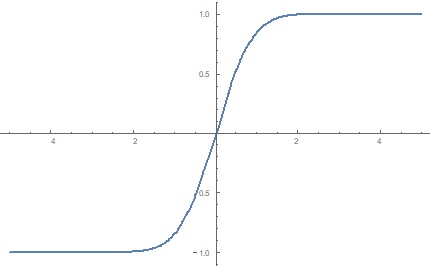#inte^(-x^2)cos(sqrt(2)x)dx#
This function cannot be written in terms of typical elementary functions, in that regard we have to use a special function. More specifically we need to use the Gaussian Error function which is defined as follows:
#erf(x) = 2/sqrt(pi)inte^(-x^2)dx#
The definition is generalized for coefficients in front of the exponent like so:
#(erf(sqrt(a)x))/sqrt(a) = 2/sqrt(pi)inte^(-ax^2)dx#
The graph of the Gaussian error function looks like this:

Several techniques can be used to deduce the behavior of the #erf(x)# function from the Guassian integral. One such method is to find the Taylor series of #e^(-x^2)# and integrate that term by term.
This is now diverting from the main question, if you wish to find out more about the Gaussian Error function then follow the link:
http://mathworld.wolfram.com/Erf.html
So now that we have been introduced to the Gaussian Error function we can answer the question, start by using:
#cos(ax) = (e^(iax)+e^(-iax))/2# so we may re-write the integral as:
#inte^(-x^2)cos(sqrt(2)x)dx =inte^(-x^2)(e^(isqrt(2)x)+e^(-isqrt(2)x))/2dx#
Now combine the exponents:
#=1/2inte^(-x^2+isqrt(2)x)+e^(-x^2-isqrt(2)x)dx#
To continue we need to complete the square of the exponents:
#-x^2+isqrt(2)x=-(x-isqrt(2)/2)^2-(-isqrt(2)/2)^2#
#=-(x-i/sqrt(2))^2+1/2#
And
#-x^2-isqrt(2)x=-(x+isqrt(2)/2)^2-(+isqrt(2)/2)^2#
#=-(x+i/sqrt(2))^2-1/2#
So; our integral now becomes:
#1/2inte^(-(x-i/sqrt(2))^2+1/2)+e^(-(x+i/sqrt(2))^2-1/2)dx#
#=e^(1/2)/2inte^(-(x-i/sqrt(2))^2)dx+e^(-1/2)/2inte^(-(x+i/sqrt(2))^2)dx#
Now substitute #u=x-i/sqrt2-> du=dx# for the first integral.
Substitute: #v = x+i/sqrt(2)-> dv=dx# for the second integral.
So we now have:
#=e^(1/2)/2inte^(-u^2)du+e^(-1/2)/2inte^(-v^2)dv#
Now, using our definition for the #erf(x)# function we can integrate this to get:
#(e^(1/2)sqrt(pi))/4erf(u)+(e^(-1/2)sqrt(pi))/4erf(v)+C#
Now we can reverse the substitution:
#sqrt(pi)/4[e^(1/2)erf(x-i/sqrt(2))+e^(-1/2)erf(x+i/sqrt(2))]+C#


